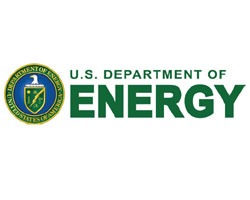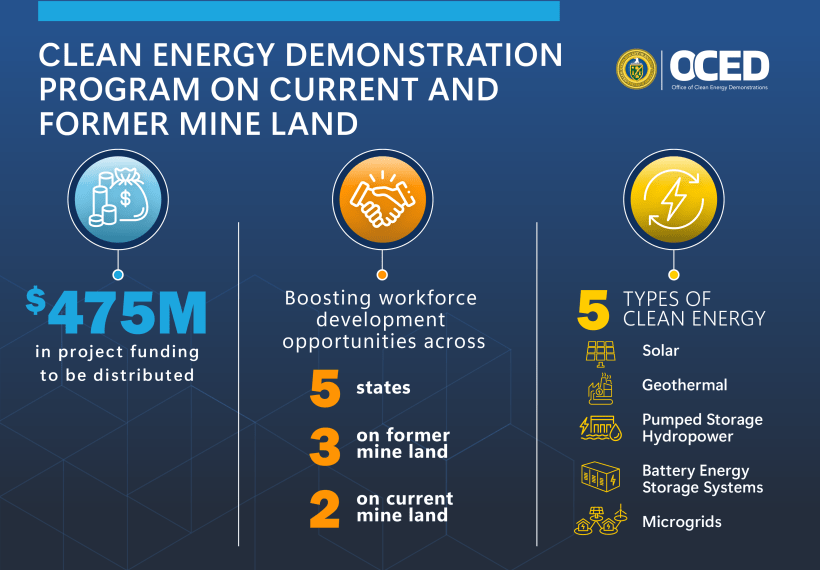
 



.gif)






|
Signature Sponsor


March 21, 2024 -
Project Name: Copper Recovery in Arizona for the Domestic Energy Supply ChainLocation: Graham and Greenlee Counties, Arizona Federal Cost Share: $80,000,000 Selectee: Freeport Minerals Corporation
Technology: Microgrid, Geothermal Clean Heat, and a Battery Energy Storage System (Current Mine – Copper) Project Impacts:
Project Summary: Copper Recovery in Arizona for the Domestic Energy Supply Chain seeks to demonstrate direct-use, geothermal, clean heat to increase responsibly produced copper. This, combined with a microgrid and a battery energy storage system, will decrease the mines’ reliance on onsite thermal backup generators, reduce its greenhouse gas emissions, and improve the energy and climate resilience of local communities. Located at Arizona’s Morenci and Safford copper mines, this project aims to demonstrate a way to use naturally occurring, geothermal heat to increase copper yields from already mined material. The project could increase copper recovery by 25 million pounds annually with the potential to increase recovery up to 40%—depending on the geothermal resources. With copper demand forecast to increase, extracting these difficult-to-access resources can help secure our domestic clean energy supply chain. Freeport Minerals Corporation (FMC) is the selectee and plans to have this demonstration project serve as a blueprint to unlock follow-on investment at other copper mines across the country. At the local level, the communities surrounding these mines would benefit from lower energy rates and reduced power outages. As part of its Community Benefits Plan, this project plans to create 121 construction jobs and 12 permanent operations jobs. FMC plans to work to continue strengthening its partnerships with hundreds of high schools, technical and community colleges, and universities to help students of all backgrounds access skills that will help them fully participate in this project and other economic benefit opportunities. The company will also continue to provide 300 annual higher-education scholarships for Native American students from 14 tribes to ensure access to quality jobs. FMC convenes Community Partnership Panels (CPPs) composed of diverse and representative stakeholders who regularly meet to ensure two-way dialogue and input. In recent years, the Greenlee County CPP voiced local concerns and interest in addressing the growing impacts of climate change in the region. In response, if this project is awarded federal funding, FMC plans to increase investments in multiple new climate resilience projects, including increased funding to Local First Arizona to finance projects focused on local climate and economic resiliency. For more information, email AZ_CEML.hq.doe.gov.
Project Name: Lewis Ridge Project (Coal-to-Pumped Storage Hydropower) in KentuckyLocation: Bell County, Kentucky Federal Cost Share: $81,000,000 Selectee: Rye Development Technology: Pumped Storage Hydroelectric (Former Mine) Project Impacts:
Project Summary: The Lewis Ridge Project (Coal-to-Pumped Storage Hydropower) in Kentucky proposes to convert former coal mine land in Bell County into a closed-loop, 287 MW pumped-storage hydroelectric (PSH) facility. This facility could provide 671,700 MWh of clean electricity annually—enough to power about 67,000 homes each year—with a daily energy storage/generation of 2,165 MWh and the potential to produce up to eight hours of dispatchable power when needed, such as during times of peak demand or extreme weather events. Pumped storage hydropower can give new life to former mine land and provide their surrounding communities with cost-effective and reliable clean electricity. To further maximize this project’s benefits, Rye Development, the selectee, plans to explore the feasibility of adding floating solar panels on the reservoirs to increase clean energy generation and minimize water evaporation. Due to the decline of the coal industry, Bell County, located in southeastern Kentucky, saw nearly a quarter of the community relocate, significantly decreasing the area’s tax revenues since 1970. As part of its Community Benefits Plan, this project anticipates creating close to 1,500 construction jobs and 30 operations jobs, adding millions in tax revenue to the community over the project’s projected 100-year lifetime. In partnership with Shaping Our Appalachian Region (SOAR), a local nonpartisan organization dedicated to improving the Kentucky Appalachian region, Rye Development has been engaging with stakeholders since Spring 2022, leading to 17 local letters of support of this project. Rye and SOAR plan to prioritize local hiring through partnerships with several unions and the Southeast Kentucky Community & Technical College and by providing a Registered Apprenticeship Program and other subsidized workforce training activities. This would ensure that workers on this project receive nationally recognized, professional credentials, building out an Appalachian clean energy workforce with skills that translate to future projects. For more information, email KY_CEML@hq.doe.gov.
Project Name: Decarbonizing Gold Mines in NevadaLocation: Elko, Humboldt, and Eureka Counties, Nevada Federal Cost Share: $95,000,000 Selectee: Nevada Gold Mines LLC Technology: Solar + Battery Energy Storage System (Current Mine - Gold) Project Impacts:
Project Summary: Decarbonizing Gold Mines in Nevada seeks to develop a solar photovoltaic (PV) facility and a battery energy storage system on three active gold mines across Elko, Humboldt, and Eureka counties. Generating clean electricity onsite at the mines would displace self-generation or grid purchase, which is primarily generated from fossil fuels. By shifting to clean energy, this project could reduce mining operations emissions by 3.5 million tons of carbon dioxide over the project’s proposed lifetime, demonstrating a replicable way the mining industry could reach net-zero operations by 2050. Reducing mining emissions is critical as the nation ramps up its domestic supply chain to meet mineral demands in the clean energy, medical, aerospace, and advanced technology industries. Nevada Gold Mines (NGM) is a Joint Venture between Barrick (61.5%) and Newmont (38.5%) and is operated by Barrick. NGM will utilize existing Community Development Committees comprised of elected local officials who will oversee allocation of the project’s community investment budget. The project estimates that construction can create approximately 300 full-time jobs, as well as internships, mentorships, technical training, scholarships, and apprenticeships to expand access to mining and energy jobs in the state. NGM is committed to meeting the state’s requirements for local hiring, health care, and fair wage standards, ensuring good-paying, high-quality jobs. For more information, email NV_CEML@hq.doe.gov.
Project Name: Mineral Basin: Coal-to-Solar in PennsylvaniaLocation: Clearfield County, Pennsylvania Federal Cost Share: $90,000,000 Selectee: Mineral Basin Solar Power, LLC Technology: Solar (Former Mine) Project Impacts:
Project Summary: The Mineral Basin: Coal-to-Solar in Pennsylvania project seeks to repurpose almost 2,700 acres of former coal mining land in Clearfield County and develop the largest solar project in Pennsylvania—a utility-scale 402 MW solar PV facility that will produce enough clean energy to power more than 70,000 homes. This project will increase regional access to clean energy and fill a critical electricity-generation gap following the closure of the Homer City coal plant. Due to the site’s topography, environmental, and geotechnical considerations, this project will serve as a demonstration for future mine land-to-solar projects in the Appalachian region and for Swift Current with approximately 1,000 MW to be developed and constructed over the next five years. The selectee, Mineral Basin Solar Power, LLC, a subsidiary of Swift Current Energy, began meeting with stakeholders in 2020, which resulted in the planning for a Community Benefits Agreement that outlines potential benefits for local municipalities. As part of its existing Community Benefits Plan, once operational, it will contribute $500 for every megawatt generated annually to Goshen and Girard townships for community improvements of over $200,000 per year. The project expects to create more than 750 construction jobs and six operations jobs, while providing $1.1 million in annual tax revenue to townships, the county, and local school district. In addition to direct job creation, Mineral Basin Solar Power, LLC plans to invest nearly $20 million in economic development to remove barriers to economic mobility and create opportunities for youths and adults seeking to upskill, right-skill, and reskill across high-demand sectors in the 27-county region. For more information, email PA_CEML@hq.doe.gov.
Project Name: A Model for Transition: Coal-to-Solar in West VirginiaLocation: Nicholas County, West Virginia Federal Cost Share: $129,000,000 Selectee: Nicholas County Solar Project, LLC, a subsidiary of Savion, LLC Technology: Solar (Former Mine) Project Impacts:
Project Summary: A Model for Transition: Coal-to-Solar in West Virginia is a 250 MW, utility-scale solar PV project proposed at two former coal mines in Nicholas County that would produce enough clean electricity to power approximately 39,000 West Virginia homes. With no feasible industrial use, these inactive mine sites provide access to existing energy infrastructure that can transmit energy to the grid. Repurposing these previously disturbed sites for solar energy development can reduce development on sensitive natural and agricultural land, produce and deliver clean power to local communities, and lay the groundwork for a regional economic revitalization starting with the workforce. Like much of Appalachia, Nicholas County experienced a significant population decline as coal production slowed. To establish a workforce infrastructure able to serve the state for generations to come, the New River Community and Technical College, Mana Group, and National Association of Counties Research Foundation plan to create a national Coal Transition Workforce Center. This project also aims to engage state labor groups and education programs, curating a curriculum and identifying pathways to good-paying, clean energy jobs. As part of its Community Benefits Plan, the project anticipates creating approximately 400 construction jobs and four operations jobs. In addition, Nicholas County Solar Project, LLC, a subsidiary of Savion, LLC, and the West Virginia State Building and Construction Trades Council signed a Memorandum of Understanding to explore a Project Labor Agreement. The project has the potential to bolster overall local economic health by contributing more than $18.5 million in property taxes over the project’s proposed 40-year lifetime, helping to fill the tax revenue gap left by retired coal mines. For more information, email WV_CEML@hq.doe.gov. |
 











|
